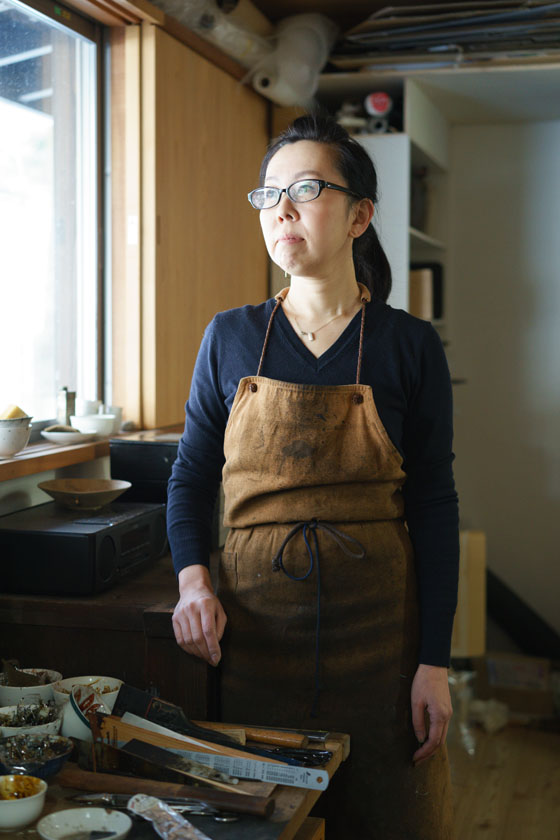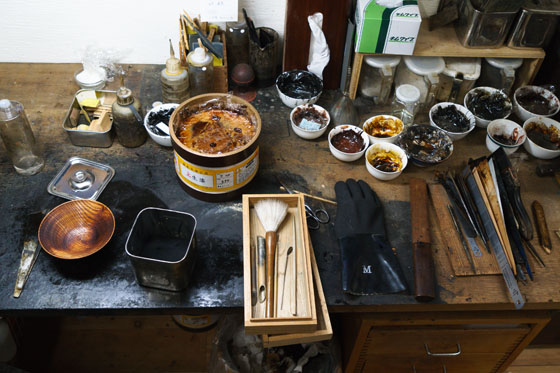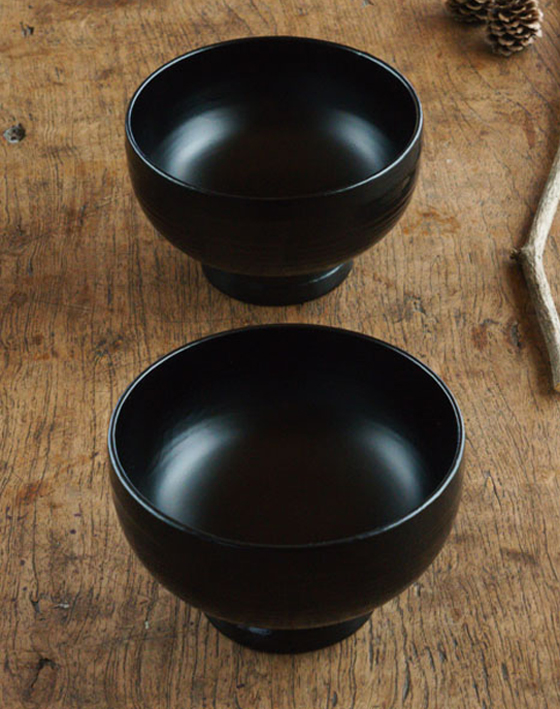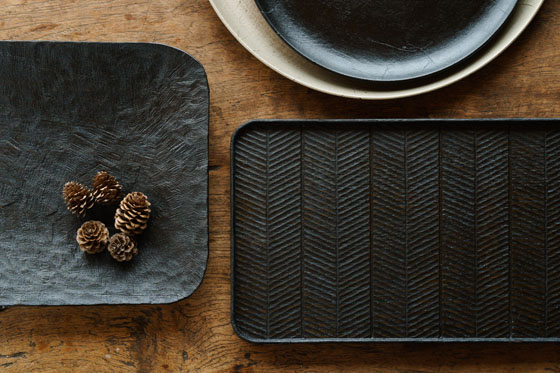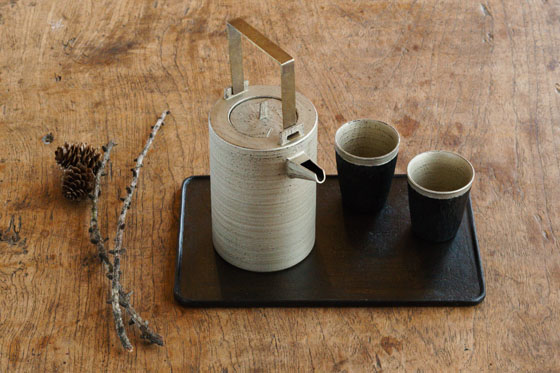Japan Stories: Junko Yashiro
Texte par 25portraits
Berlin, Allemagne
10.07.17
Junko Yashiro talks about her career and the unique process she uses to create urushi lacquerware for the third installment of Japan Stories.
Junko Yashiro is an urushi lacquerware artist who does initial woodwork in addition to applying lacquer. The objects she creates are only for daily use. Her unique style produces beautifully crafted surfaces that combine the rough textures of wood with urushi coats ranging from black to silver.
Junko Yashiro talks about her career and her unique urushi lacquerware style.
How did you discover lacquerware as a profession?
After middle school I went to an art-related school that inspired me to become an urushi lacquer artist. I was supposed to go to their associated university. Somehow during highschool, I realized that I wanted to see more of the outside world. So I took my exam to enter one of the best art universities in Japan.
During my college years I didn’t think I would be able to become an artist. I didn’t have the desire to do that. I wanted to be employed by a company. There were certain companies where I wanted to get a job after graduation, but I failed. So I had to think about what to do next. I did not feel like an artist, but wanted to create something with my hands.
There were two well-known urushi lacquer artists who inspired me. One was Mashiki Masumura. I saw some of his art pieces in a book before my professor at university took me to one of his exhibitions. I was very inspired and I thought – it doesn’t matter if an artwork is traditional or design-like, when an art piece is awesome, it’s awesome!
The second one was Tatsuaki Kuroda, who inspired me particularly in by his definition of beauty. Actually both of them worked in certain periods. With the help of that inspiration, I was confident enough to create my own timeless pieces, even without any experience.
Urushi pot and lacquering utensils (top). Classic bowls for soups or rice with black urushi lacquering (middle). Applying the first lacquer coat on a wooden bowl (bottom)
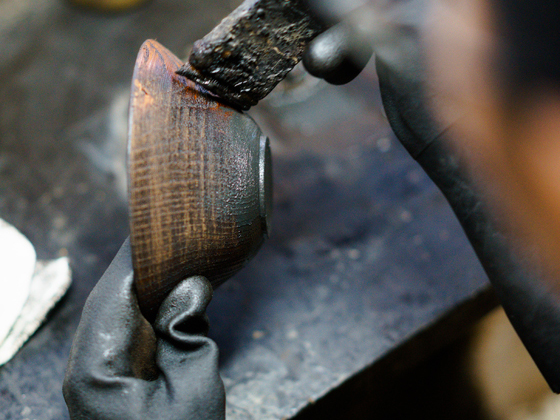
Urushi pot and lacquering utensils (top). Classic bowls for soups or rice with black urushi lacquering (middle). Applying the first lacquer coat on a wooden bowl (bottom)
×How do you see yourself within a world with mass produced goods?
I do not want to give up, but I can accept the situation. Of course it doesn’t feel good to know many products are of cheap quality. And I know that my own works are not inexpensive, and I am aware that there are not many people willing to buy my works as daily tableware. So, I think they can coexist side by side with convenient products. I hope my works transport the beauty of Japan and its culture. It is a difficult task to make people aware of objects that are of better and sustainable quality. I would like to give everybody the opportunity to feel the real things.
Is it possible to repair your works with the lacquer technique if they have cracks?
Lacquerware is definitively usable as long as the owner wants, even longer than lifetime. Breaks are fixable but this needs a lot of effort. Clients like restaurants often send in some earlier works or something with scratches or cracks to get fixed by me. And I am happy about that, because it is an indication that the pieces are used in their daily life.
In contrast to other lacquerware artists, you also do the complete woodworking process beforehand.
In the early years after graduation, I hadn’t earned enough money for purchasing special tools or machines. So I tried to find someone who was able to produce the wooden parts according to my drawings. The results were not good enough. Furthermore, the woodworking suppliers were far away from my hometown. I didn’t have the chance to check their work promptly, and I certainly was not prepared to present those works as mine. So I decided to do the whole process by myself. Later I was able to buy some tools from what I made at a side job I had at the time.
Woodworking lathe with a finished bowl (top). Pieces for scents and tea made of wood with varying textures and urushi lacquering (bottom)

Woodworking lathe with a finished bowl (top). Pieces for scents and tea made of wood with varying textures and urushi lacquering (bottom)
×Yesterday we saw you using the electric chain saw for the initial shaping of one of your bowls and for finishing the surface for one of your trays.
I used a chainsaw in my 20s, but only for cutting wood, not for texturing. One day, by chance, I had the idea to use a chainsaw for a wooden surface, and I still like to work with it.
What are the differences between your work and more traditional lacquerware?
The difference between my work and lacquerware with a more traditional style from other regions of Japan is that they more or less copy ancient pieces. Of course, the skills and techniques most traditional Japanese artisans making these pieces have are highly developed and impressive. But for me, it doesn’t feel like living art. And there would not be enough passion involved for me. Consumers would also think it’s unreasonable to spend so much money for a perfect but copied art piece. These were my reasons against learning from a traditional artist. I was not sure what to do after graduation but I had some ideas … and they became real.
Wooden trays with hand-shaped textures (top). Junko Yashiro’s home with her studio annex in the woods of Karuizawa (bottom)

Wooden trays with hand-shaped textures (top). Junko Yashiro’s home with her studio annex in the woods of Karuizawa (bottom)
×You often use special lacquer like a deeper black or a silvery colour.
Black pigments in urushi lacquer are the basic ingredients. I looked for a deeper black for some pieces and found out a special pigment from pine soot works very well. A thinner application is the best for keeping textures in the wood visible. A dark brownish colour is also one of my favourites.
Tin powder is another fundamental ingredient for urushi lacquering. In my work, it is often the silver base preceding further treatment of the surfaces, and it nicely shows the imperfections of surfaces and structures. I especially like a blackened chainsaw surface in combination with a tin lacquer.
What inspires you?
Many things that I see, for example, things in magazines or books can be inspiration. Not only for a whole piece, but also for part of a texture. When I see something, I start sketching immediately. When I have enough ideas for a new work, I start shaping the wood.
What kind of plans or dreams do you have for the coming years?
After some years of working in my current style, I want to develop a kind of new product line with the Fuki-Urushi technique. I'm not sure about the details yet, but I definitely want to create something new.
Modern sake set with black and tin powder urushi lacquering
This is an excerpt of the interview with Junko Yashiro held in February 2017 in Karuizawa, Nagano.
Photos: Katharina Zettl and Uwe Roettgen
...
About 25portraits
25portraits is a book and documentary project about the inspiring workshops, materials, production processes, products and personalities of 25 craftspeople from all fields of Japanese arts and crafts.

